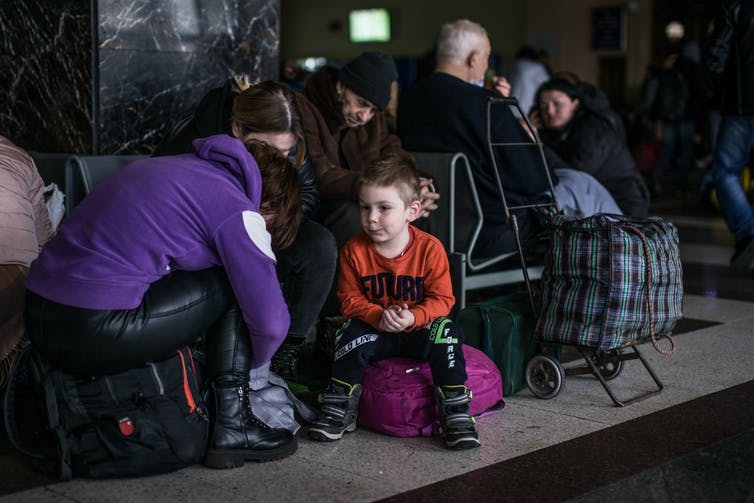Conflicts seem to be inherent in the human condition. We just have to take a look around us: right now – mid-March 2022 – according to the Foundation for International Relations and Foreign Dialoguethere are at least eleven declared wars, not counting other latent armed conflicts in various parts of the world.
This could suggest that the human species is especially violent. That’s right? Because, while genuine atrocities are taking place, including premeditated attacks against civilians, we also constantly see exceptional solidarity and compassion. It’s compatible?
Competing is inherent in all living beings, violence is not
In studies of human behavior, the conflict It is defined as a fight or competition between individuals or between groups of individuals. Competition is inherent in all living beings: we compete for resources, especially when these are limited. This competition can lead to the manifestation of aggressive behavior and violence, although the latter, as we will see, is not strictly necessary.
And perhaps this is where the crux of the matter lies. Because while competition is inherent in life, so is cooperation.
Refering to aggressiveness, is a behavioral trait present in most animal species, including people. It is generated from some emotional responses, basically those focused on fear and anger. They are not synonyms.
The afraid is the emotion that drives us to flee or hide from a threat, while the go to It urges us to fight against the supposed threats, not as a manifestation of violence but as a simple self-protection mechanism. Especially when we perceive that flight is not a possible or acceptable option.
Distinguish between violence and aggressiveness
Violence and aggressiveness are not synonymous words. The violence it is nourished by aggressive behaviors, but it goes much further: it mixes them with social and group conditions. In this sense, one of the most powerful forces of individual and collective mobilization is the ideological.
The identity samplessuch as flags and national anthems, activate the production of oxytocin in the brain. It is a neurohormone that, among many other functions, facilitates socialization. But it also lays the foundation for groupism.
It is a complex issue, in which we must be very cautious. It is not a question of looking for “good guys” and “bad guys”, but of understanding why we sometimes act the way we do, explaining human behavior not to justify it but to contribute to the prevention of conflicts or, at least, to their dialogue resolution, away from the use of force.
Groupism and double standards
Let’s delve into groupism, at the base of many conflicts. Evolutionarily, the human species has adapted to life in groups, or tribes, and the brain responds to this in a very peculiar way. Already from birth, instinctivelearns to differentiate “their own”, people from their own group, from “the others”, people from other groups, and immediately begins to establish a rule of double standards.
various studies have shown that, in adults, within a few days of first joining a newly formed group whose members did not know each other before, one begins to perceive their peers as more honest, reliable, intelligent, hard-working, friendly and even handsome than members of other groups. Although neither one nor the other knew anything previously. The group mind has gone into action.
From these differences, manipulation is easy. It is enough to increase the perception of dishonesty or any other negative aspect of the members of another group for unnecessary rivalries to start, which can lead to conflict.
Furthermore, when this negative perception is intense enough, it can even lead to reify to the people in the other group. In other words, to stop considering the people of a supposedly rival group as human beings, which facilitates the barbarism to which many armed conflicts have sadly accustomed us.

Flikr / UNDP Ukraine, CC BY-ND
Leaders with mental illnesses
To all this we must add the possibility that there are mental pathologies in some leaders that contribute to driving their fellow citizens to war. A study published in 2006 showed that 49% of US presidents who had served in office between 1776 and 1974 had symptoms of some type of mental disorder, including depression, anxiety, bipolar disorder and substance abuse, mainly alcohol .
All this without counting on the so-called hubris syndrome, or arrogance, which develops in a significant number of people who hold positions of power (political, economic, scientific, cultural, etc.). And it is characterized by boundless ambition and reckless and insolent behavior.
Let’s go back to aggressiveness. As has been said, it is part of our human nature as a self-protection mechanism against possible threats. But violence is perfectly avoidable, through social humanization and educational of the others”.
This also explains the incredible displays of solidarity that conflicts generate. Of course, it is a solidarity that occurs much more easily with those people who, within the conflict, we consider as more than “ours”. The group brain is always in action, so it is crucial to maintain a social climate of dialogue to avoid conflicts or solve them when they begin to occur, without reaching greater evils.
All this happens, as has been said, through social experiences and, very especially, through educational experiences.
Education influences the connections that are established in the brain. Therefore, an education that favors dialogue and reflection between diverse opinions would facilitate the peaceful resolution of conflicts. And also the opposite if education is dedicated to exploiting differences and excessive competition.
We are, in short, an aggressive species and at the same time supportive and compassionate. But that can become violent depending on the social conditions in which we are formed as people.
David Bueno i Torrens, Professor and researcher of the Section of Biomedical, Evolutionary and Developmental Genetics. Director of the Chair of Neuroeducation UB-EDU1ST., University of Barcelona
This article was originally published on The Conversation. read the original.